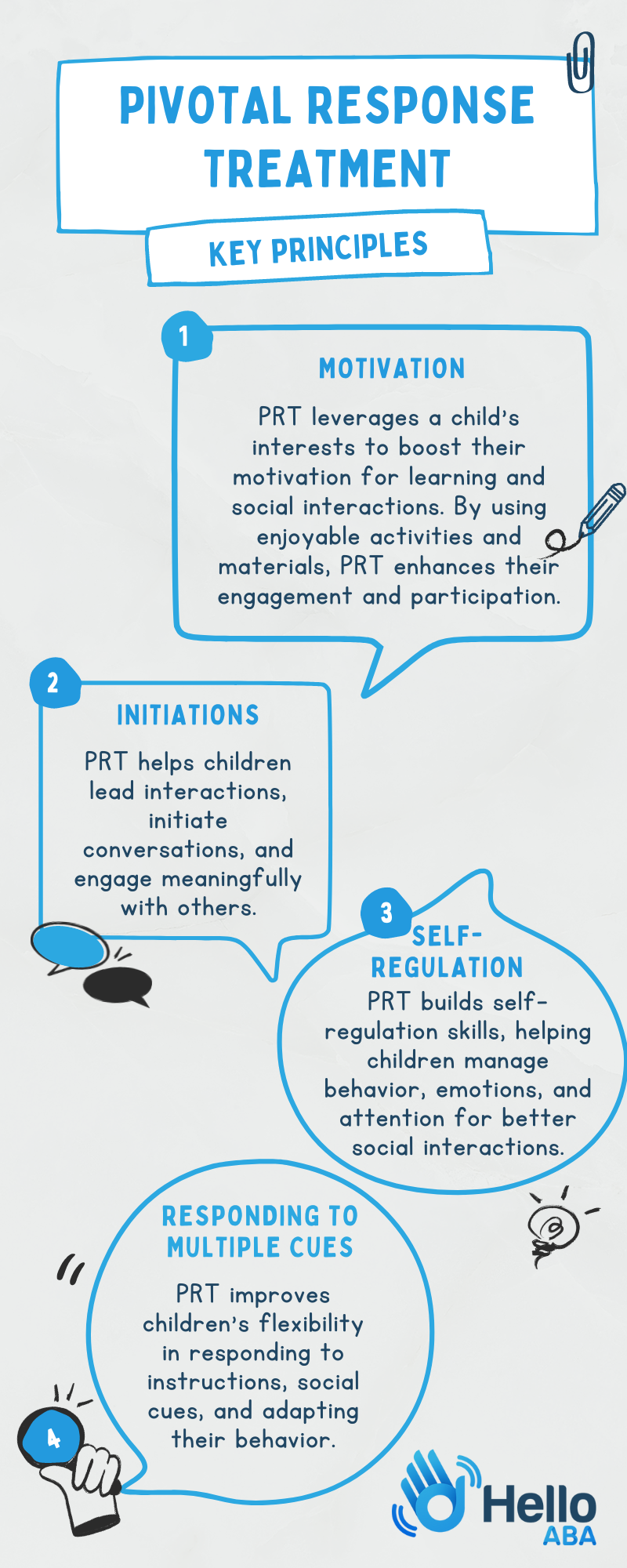Pivotal Response Treatment (PRT) is a naturalistic intervention model derived from applied behavioral analysis (ABA) that focuses on improving “pivotal” areas of child development rather than individual behaviors. The goal of PRT is to spark widespread progress in other developmental areas by targeting changes in pivotal responses.
Definition and Overview
Established in the 1970s by Dr. Robert Koegel and Dr. Lynn Kern Koegel at the University of California, Santa Barbara, PRT was initially known as the Natural Language Paradigm (NLP) or pivotal response teaching. It has since evolved into a comprehensive treatment approach for individuals with autism spectrum disorders.
PRT utilizes a play-based approach to therapy, utilizing naturalistic teaching strategies to enhance a child’s social and communication skills. By focusing on “pivotal” areas of development, PRT aims to improve a child’s overall functioning and ability to engage with others effectively.
Key Principles of PRT
PRT targets four main “pivotal” areas of a child’s development to address negative, self-stimulatory behaviors associated with autism. These areas include:

Targeting these pivotal areas, PRT aims to create a positive ripple effect, leading to improvements in other areas of development, such as language and social skills.
Understanding the principles and approach of PRT sets the foundation for implementing this effective treatment model. In the next section, we will delve into the practical aspects of implementing PRT, including the play-based approach and the use of natural reinforcements.
Implementing PRT
To effectively implement Pivotal Response Treatment (PRT), therapists and caregivers utilize specific techniques that are central to this intervention approach. Two key components of implementing PRT are the play-based approach and the use of natural reinforcements.

Play-Based Approach
PRT is known for its play-based approach, which involves using play as a natural and enjoyable context for learning. By incorporating play into therapy sessions, children with autism are motivated to engage and interact with others. The play-based approach allows for a more natural and meaningful learning experience, as it taps into the child’s interests and preferences.
During play-based PRT sessions, therapists and caregivers create opportunities for the child to initiate communication, take turns, and engage in reciprocal interactions. This approach helps the child develop important social and communication skills, such as starting conversations, responding to questions, and participating in ongoing dialogue. By targeting these pivotal areas of development, PRT aims to facilitate broader progress in sociability and overall functioning.
Natural Reinforcements
In PRT, natural reinforcements are used to motivate and reward the child for making meaningful attempts to communicate or engage in desired behaviors. The focus is on providing reinforcements that are intrinsically related to the activity or context, rather than relying solely on external rewards. By using natural reinforcements, PRT aims to increase the child’s desire to participate and interact with others.
For example, in a play-based PRT session, the reward for a child’s meaningful attempt to ask for a toy could be the opportunity to play with it. This natural reinforcement helps to strengthen the child’s motivation to communicate and engage, as they see the direct connection between their efforts and the enjoyable outcome.
Implementing PRT techniques that emphasize a play-based approach and natural reinforcements, therapists and caregivers can create a supportive and engaging environment for children with autism. This approach allows for personalized and meaningful interventions that address the unique needs of each child.
Benefits of Pivotal Response Treatment
Pivotal Response Treatment (PRT) offers several benefits for individuals with autism and their families. Let’s explore two key advantages: age range suitability and parental involvement and support.
Age Range Suitability
One of the remarkable aspects of Pivotal Response Treatment is its suitability for individuals of all ages, from infancy through adulthood. Unlike some other treatments that may be more focused on specific age groups, PRT recognizes that individuals with autism can benefit from intervention at any stage of their development.
For younger children, PRT utilizes play-based approaches to engage them in learning and social interactions. These approaches capitalize on the child’s natural interests and motivations, making the therapy enjoyable and effective. As individuals grow older, the motivators used in PRT can evolve to include activities, conversations, games, or outings that are age-appropriate and align with their interests.
Tailoring the therapy to the individual’s age and stage of development maximizes the effectiveness and relevance of PRT, addressing the unique needs and goals of each person.
Parental Involvement and Support
Another significant advantage of Pivotal Response Treatment is the substantial amount of parental involvement and support it incorporates. Parents play a vital role in their child’s development, and PRT recognizes the importance of their active participation.
Through PRT, parents learn how to best support their child’s social and communication development. They acquire strategies and techniques that they can implement outside of therapy sessions, creating a consistent and supportive environment for their child’s growth.
The treatment is individualized to each child’s interests, ensuring that parents receive guidance specific to their child’s needs. This personalized approach empowers parents to become effective advocates and facilitators of their child’s progress.
Involving parents in the therapy process extends PRT beyond the clinic or therapy room, creating opportunities for continuous learning and application of skills in the natural environment. This holistic approach strengthens the child’s development and supports the family unit as a whole.
Pivotal Response Treatment offers numerous benefits, including its suitability for individuals across different age groups and the extensive involvement of parents. By targeting pivotal areas of development and incorporating positive reinforcement, PRT promotes social and communication skills while empowering families to support their child’s progress.

PRT Techniques
Pivotal Response Treatment (PRT) is a naturalistic intervention model derived from Applied Behavior Analysis (ABA). Unlike traditional ABA, which focuses on addressing individual behaviors, PRT targets four key “pivotal” areas of a child’s development. These areas include motivation, initiations, self-regulation, and responding to multiple cues. By addressing these pivotal areas, PRT aims to spark widespread progress in other developmental domains. Let’s explore two important techniques used in PRT: targeted development areas and positive reinforcement in therapy sessions.
Positive Reinforcement in Therapy Sessions
Positive reinforcement plays a crucial role in PRT therapy sessions. The use of natural reinforcements is a key component of this approach. In PRT, the reward for a child making a meaningful attempt to engage in a targeted behavior is the opportunity to engage in an activity they find reinforcing or enjoyable. This natural reinforcement helps motivate the child to want to interact and engage with others.
For example, if a child makes a meaningful attempt to ask for a toy, the reward would be the opportunity to play with that toy. By linking the child’s attempts with positive outcomes, PRT helps reinforce and strengthen the desired behaviors.
In therapy sessions, therapists use a variety of strategies to provide positive reinforcement, such as praise, access to preferred activities or toys, or social interactions. This positive reinforcement helps create a positive and enjoyable therapy environment, increasing the child’s motivation to actively participate and learn.
Targeting pivotal development areas and incorporating positive reinforcement, PRT aims to maximize potential and promote progress in various areas of a child’s development. It’s crucial to note that PRT is highly individualized, considering each child’s unique needs, interests, and routines. Additionally, parental involvement and support are integral to the success of PRT, as parents learn how to best support their child’s social and communication development.

PRT Compared to Other Treatments
Exploring treatment options for individuals with autism involves understanding how Pivotal Response Treatment (PRT) compares to other interventions. PRT offers unique aspects that set it apart from traditional approaches, and its effectiveness has been supported by numerous studies.
Unique Aspects of PRT
Pivotal Response Treatment focuses on improving “pivotal” areas of child development, rather than targeting individual behaviors. This naturalistic intervention model, derived from applied behavioral analysis (ABA), aims to spark widespread progress in other developmental areas by addressing changes in pivotal responses.
One of the distinguishing features of PRT is its play-based approach. Unlike some traditional interventions that rely heavily on structured teaching methods, PRT incorporates naturalistic teaching strategies that make learning enjoyable for the child. This approach helps foster motivation and engagement, leading to more meaningful progress.
Effectiveness and Studies
Pivotal Response Treatment has been extensively studied and has shown positive outcomes for individuals with autism spectrum disorders. Research has demonstrated improvements in communication skills, social interactions, and overall language development in children receiving PRT.
Studies have also shown that PRT can lead to generalization, which means that skills learned in therapy sessions can be applied to various settings and situations. This is a crucial aspect of treatment, as it allows individuals to use their newly acquired skills in real-life scenarios.
The positive, naturalistic aspects of PRT contribute to its effectiveness. By using reinforcement strategies that are meaningful and relevant to the child, PRT enhances motivation and engagement, leading to more significant progress in targeted areas.
It’s important to note that while PRT has shown promising results, treatment approaches should be tailored to the individual’s unique needs and preferences. Consulting with professionals experienced in PRT can help determine if it is the most suitable intervention for a particular individual.
Considering the unique aspects of PRT and its proven effectiveness, individuals with autism and their families can make informed decisions about the most suitable treatment options. The naturalistic and individualized approach of PRT, coupled with its focus on pivotal areas of development, makes it a valuable intervention for promoting progress and transforming lives.
For those exploring ABA therapy in Montgomery County, Hello ABA offers expert ABA therapy tailored to individual needs. Get in touch today to schedule a consultation or book an appointment.






